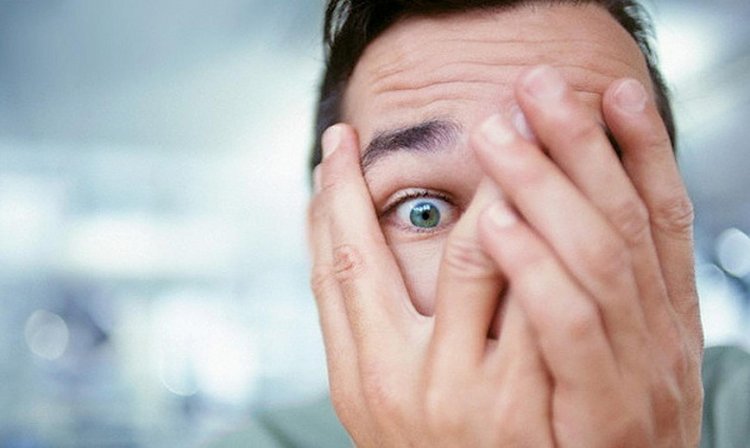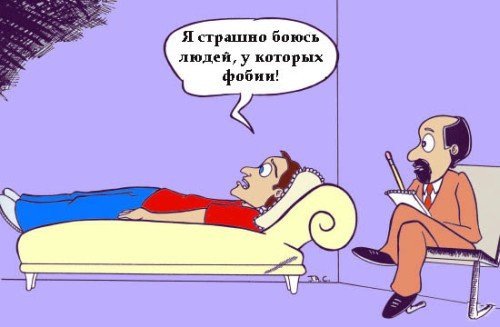People live in a constant state of stress. They continuously “absorb” all external stimuli. Fear and stress are two factors that negatively influence human mental and physical health. It is inherent in the body that regardless of our mood and state of mind, we are subject to external changes. Human fears often arise in childhood and adolescence. Some actions, objects, natural phenomena or animals can frighten a person and set the fear of what has happened in their subconscious. Hence phobias are uncontrollable human fears that manifest themselves through negative memories.
The symptoms of all kinds of phobias are similar and resemble the signs of a panic attack. These include palpitations; difficult breathing and choking; dry mouth; a sharp increase in blood pressure; discomfort in the stomach, which may be accompanied by nausea; pain or pressure in the chest area; trembling; dizziness; increased sweating; leg weakness; feeling of the unreality of what is happening or of oneself.
Scientists have identified 3 reasons for the inexplicable fears around us:
- Biological phobias (also known as hereditary) – fears that manifest themselves at the genetic level. If one of the parents suffers from a phobic disorder, there is a risk of the phobia in the child. However, experts say that genetic predisposition to one or another disorder is unlikely.
- Psychological phobias are mental disorders that can be traced back to traumas or events and lurk at a subconscious level. Incorrect explanation of certain words or actions, an incorrect view of current and future events, character impairment and other psychological problems can also affect the occurrence of phobias. During such panic attacks, the person is unable to control their emotions and actions. Anything that the subconscious mind produces can become devastating to the person.
- Social phobias include the effects of external factors, often occurring in childhood. These can include animal or insect bites, as well as their size and appearance; bad experiences with swimming in open waters; fear of small enclosed spaces, and more. Sociophobes – this is the name given to the people who not only experience anxiety from the external environment, but also avoid society as a whole. Thus, a person suffering from this disorder is in every way afraid that their actions or detected anxiety will be negatively assessed by others. As a result, a sociophobe shields themselves from actions that cause fear or anxiety. Yet most people sometimes make this phobia up by defining themselves as a sociophobe. It should be noted that a person who really suffers from sociophobia will always feel uncomfortable being in society, not just when they are in a certain mood.
Today there are a lot of phobias that are present in literally every person on Earth. One of the most well-known human phobias is claustrophobia. Fear of confined spaces. Although its practical importance is not so great, but in medicine claustrophobia can be a serious factor preventing CT and MRI examinations.
Nosophobia – fear of getting ill with any serious disease, arising through panic disorder: cardiophobia (fear of heart disease), carcinophobia (fear of cancer), AIDS phobia (fear of HIV infection), mysophobia (fear of pollution), lisophobia (fear of going insane), thanatophobia (fear of death in general), etc.
Agoraphobia – fear of the marketplace, in the exact sense – fear of open spaces (streets, squares) as well as places with large crowds of people. Today, this phobia is defined as a fear of being left unaided in an unfamiliar place. It leads to avoidance behavior: people suffering from agoraphobia are forced to considerably reduce the number of independent exits outside their house (sometimes they do not leave it for years), although they usually can do it when accompanied by relatives. Agoraphobia can develop on its own, but is much more often accompanied by the panic attacks that in these cases have pathogenetic importance for the development of agoraphobia. Panic attacks occur during an anxiety attack and last for about 30 minutes.
Phagophobia – fear of swallowing food because of the possibility of choking. Often refers only to swallowing medications (especially large capsules). People with this disorder do not always tell their prescribing doctors about it. To safely swallow a capsule or tablet, they crush them into a powder, including those that must not be crushed, because it significantly changes the pharmacological properties of the medication. Consequently, when prescribing large pills, the doctor should ask whether the patient is able to swallow them.
Aerophobia is the fear of flying on an airplane. The person only travels by ground transport and avoids flying in every possible way.
Fear of objects is characterized by the fear of specific objects, which develops after some negative situations involving a particular object (sharp objects, mirrors, weapons, dolls). Fear of a certain color, size or shape of objects also relates to this type of phobia.
Zoophobia is a stressful situation that occurs in the presence of a certain kind of animal. It often occurs toward wild or aggressive representatives of the animal world. But this phobia is activated only during an open encounter between a person and an animal.
Nyctohylophobia is not the most common type of phobia, but this fear is directly connected with nyctophobia – a panic fear of the darkness. So, nyctohylophobia is the fear of dark woods. People who suffer from this phobia always see terrifying silhouettes coming from trees in the dark.
In 2020, many people have experienced the anxiety associated with COVID-19. Coronaphobia, as the new phobia may now be called, is a panic fear in humans of contracting a coronavirus infection with severe health consequences. Some psychologists characterize this kind of anxiety as exaggerated. People have a supposed fear of various manifestations of COVID-19. This kind of disorder disrupts the usual course of human life. Compulsive actions of disinfecting all surrounding surfaces arise – people perform rituals of disinfecting with strong disinfectants not only those items purchased over the Internet and delivered by courier. Psychiatrists suggest that the longer the illness incidence grows and self-isolation continues, the more likely people are to develop these fears.
This is only a fraction of the phobias that people are exposed to. One can experience panic and fear of any object or phenomenon, not only those that actually exist in life, but even those that are imagined. The main thing is to be able to manage your fears and not give in to panic attacks.
Sources:
Strange phobias of the 21st century.
Primal fear: phobias of the 21st century.
Photo source in the text and on the homepage – Fear... How to fight it?























